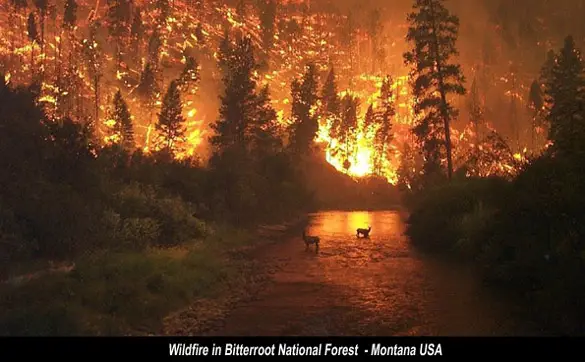博文
气候变化与野火
||
引自:
Climate Change and Wildfires: Wildfires, also known as a forest fire, vegetation fire, grass fire, brush fire, peat fire ("gambut" in Indonesia), bushfire(in Australasia), or hill fire, are uncontrolled fires often occurring in wild land areas, but which can also consume houses or agricultural resources. Common causes include lightning, human carelessness, arson, volcano eruption, and pyroclastic cloud from active volcano. El Niño (weather pattern disturbance), heat wave and drought are major contributors to extreme forest fires.
Causes
Wildfires are a growing natural hazard in many regions of the world, posing a threat to life and property, particularly where native ecosystems meet developed areas. However, because fire is a natural(and often beneficial) process, fire suppression can lead to more severe fires due to the build-up of vegetation, which creates more fuel. In addition, the secondary effects of wildfires, including erosion, landslides, introduction of invasive species, and changes in water quality, are often more disastrous than the fire itself.
The current increase in instances of wildfire can be explained by four key factors:,
1. Past fire suppression policies, including one of "total suppression," which allowed for the accumulation of fuel in the form fallen leaves, branches, and excessive plant overgrowth in forest and wild land areas.
2. Increasingly dry, hot weather.
3. Changing weather patterns across many regions
4. Increased residential development in the wild land/urban interface.

Wildfires Increasing
Wildfire area-burned numbers were at unprecedented levels in the 2002 summer. Over the years devastating fires have torn through California and Colorado, well after the summer season. In February 2009, at least 108 people died in the Victorian state of Australia in terrible fire storms. These fires were the worst in the 200 years of European settlement.
Increased forest fire risk is also a crucial factor in the survival of boreal forests in Russia. Most dangerous are large forest fires, which occur during extremely dry and warm years. Such climatic conditions occur periodically (every 15–20 years) in parts of the Russian boreal zone. Currently these large fires account for about 1–2% of the total number of forest fires, but burned areas reach 70–80% and losses are as much as 90% of the total values. Most climate scenarios indicate that the probability of large fires will increase.

Climate Change and Wildfires
As the climate warms, the atmosphere can hold more moisture, and precipitation is likely to increase in winter, but with more falling as rain rather than snow. Increased melting of snow further adds to the likelihood that snow pack in the mountains and on the plains is less as spring arrives, making less melt water as the summer looms. Drier soils mean less evaporation and so the heat goes into higher temperatures, less recycled moisture in the atmosphere, and hence less rain during summer. With increased drying, it is a recipe for increased intensity, frequency and duration of drought. Increased heat waves and risk of conflagration follow.
The climate related variables that affect the severity of the a fire season are those that affect soil moisture content, vegetation density, and the moisture content of live vegetation. Extended periods of above-normal temperatures and below-normal rainfall are key factors that contribute to an active wildfire season. Available moisture is rapidly lost due to high evapotranspiration rates under hot and dry conditions. If the losses due to evapotranspiration are not replaced through precipitation, below-normal soil and vegetation moisture levels increase the potential for wildfire development. Climate change and wildfires are clearly linked! cli
athange and wildfires
Page last updated 9 February 2009
Climate Change and Wildfireshttps://blog.sciencenet.cn/blog-80178-213926.html
上一篇:澳大利亚大火死亡人数在继续上升Australian fire death toll rises
下一篇:溢油事件